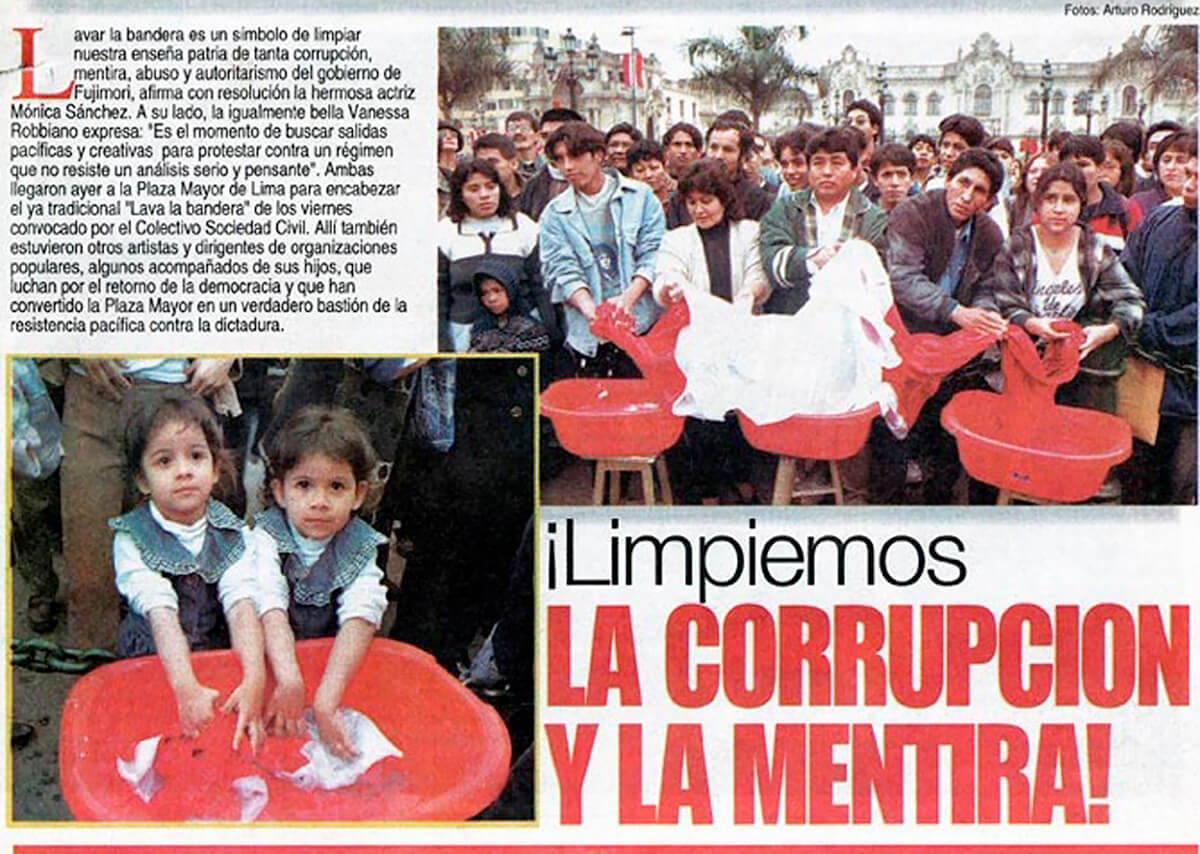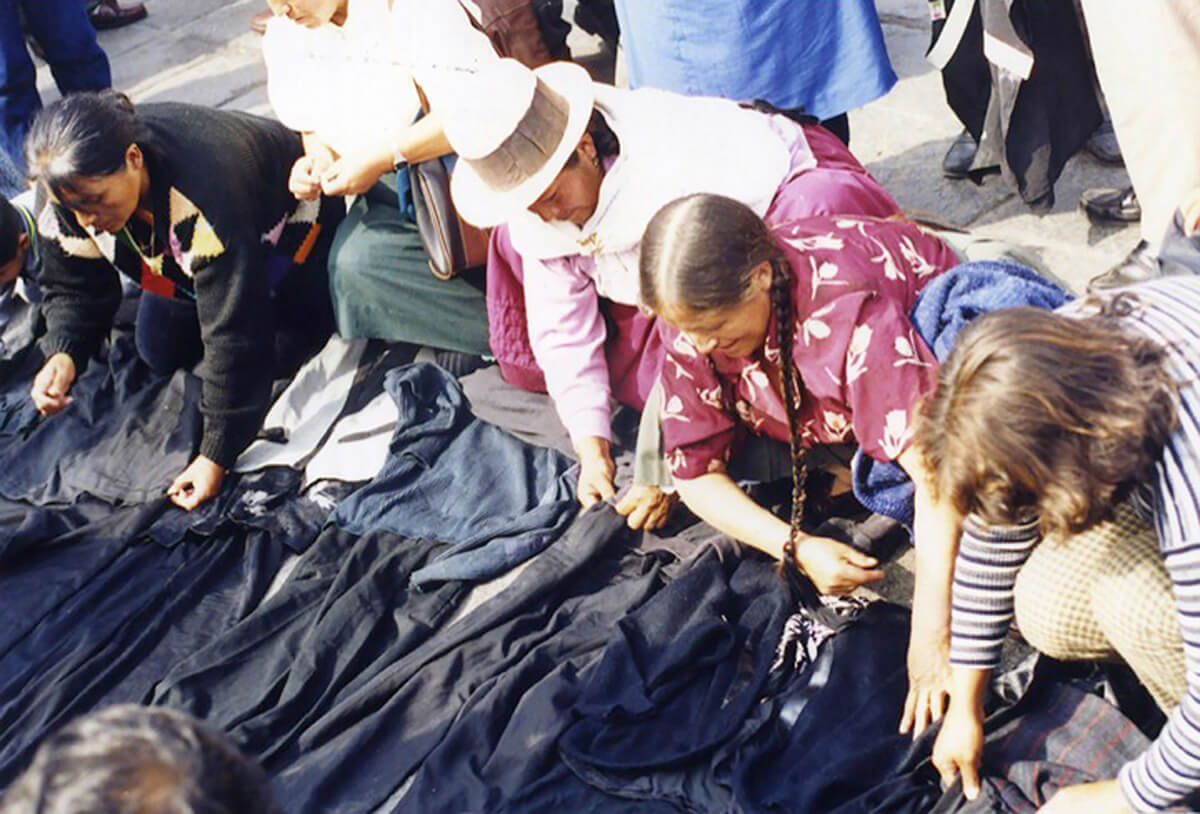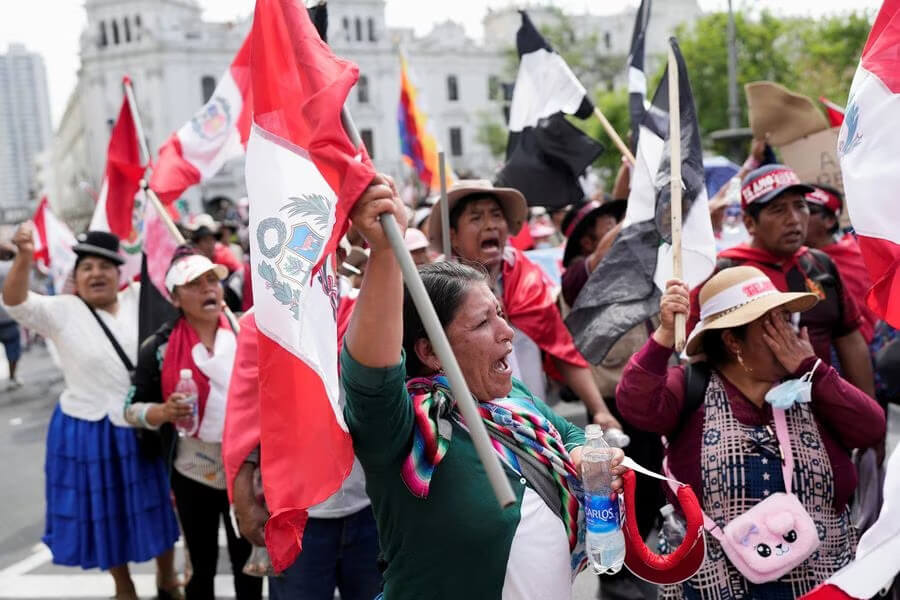
The report of an endless struggle for democracy in Peru
Interview with Claudia Coca
by Sur Journal
For this issue of Sur, in our gallery of art pieces, we have included the photographic record of a paradigmatic action staged by Colectivo Sociedad Civil in Peru in the year 2000 named “Lava la bandera” (Washing the flag). This political and collective intervention, carried out as a symbolic call for democracy, challenged the meaning that had been historically attributed to the flag as an insignia, a distinctive mark of a people. Bringing national flags to city squares and washing them collectively both expressed criticism of a tattered symbol and its fragile representation capabilities and used many hands to forge other possible meanings.
The context in which the action was carried out was very specific. The systematic violation of human rights, political persecution, corruption, and poverty were all present throughout the dictatorship of Alberto Fujimori in the country.
Today, Peru is once again facing a profound political crisis. A crisis that, within a little over a month, has left an alarming number of people dead and injured due to violent repression by the state against demonstrators.11. “Guterres preocupado com protestos no Peru que mataram dezenas”, ONU News, January 26, 2023, accessed January 30, 2023, https://news.un.org/pt/story/2023/01/1808777. Thousands of people have taken to the streets of Peru, waving their flags high – the flags of a country that, like twenty years ago, is now experiencing a moment of instability as the result of severe national inequality, structural racism, and an institutional crisis made evident by the systematic violation of human rights.
In this brief interview with Sur, Claudia Coca, a Peruvian artist, political activist and teacher, tells us about her experience with Colectivo Sociedad Civil at the time of the “Lava la bandera” interventions. Among other things, she mentions the expectations of the time, the meaning and impact of these street art actions that filled many public squares in Peru, and, finally, about the timeless importance of re-signifying and appropriating the symbolic value of the flag to create collective actions in the face of human rights violations and as part of a constant quest to maintain democracy.
Sur Journal •Tell us about Colectivo Sociedad Civil. Which ideas united its members and who were its members?
Claudia Coca • To me, Colectivo Sociedad Civil was a collective of citizens that wished to engage civil society in order to recover democracy. In 2000, with a great deal of naivety, we endorsed the following motto: “For the cultural overthrow of the dictatorship”, and I say naivety because we never expected to be in the same situation today, and I say this with desperation and pain.
We were few at first and many at the height of the struggle for democracy.22. The founding members of Colectivo Sociedad Civil come from the world of visual arts. In the first weeks of its formation, creation and work, members included, in addition to Claudia Coca, Susana Torres Márquez, Abel Valdivia, Emilio Santisteban, Sandro Venturo, Gustavo Buntinx, Fernando Bryce and Natalia Iguiñiz.
Sur • What was most notable for you as a group when carrying out the “Lava la bandera” action?
C.C. • We were in the streets for many months with multiple citizen actions. Although “Lava la bandera” was the most famous one, we had crucial experiences at different moments. From my perspective, I can say that the most notable aspect was the union of citizen strength; we started out as a few and we ended up with many participants in the collective who went out to carry out multiple symbolic actions against the dictatorship.
The importance of the “Lava la bandera” action was that it was maintained for six months, before, during, and after the fall of Fujimori. Washing the flag every Friday at the Plaza de Armas led this action to be replicated in other regions of the country. Even Peruvian citizens in other countries would replicate the action in squares and embassies. We did not coordinate these actions; they were the initiative of the citizens themselves.

Documentation of the media coverage of the actions of the Sociedad Civil Collective. Archives provided by artist Claudia Coca.
Sur • How do you interpret the repercussion and the political effect that the actions had in comparison to your early expectations?
C.C. • The democratic media outlets covered the actions, which were later published by printed media, on the radio, and on television. This was very important for the public to see symbolic actions of a peaceful and thought-provoking nature. It was important to us to be accompanied by the media, particularly for safety reasons, and this was an important factor in attracting more citizens to participate. A different kind of protest by citizens meant that the fear of being persecuted and labeled a “terrorist” was subsiding, and this is why we went out to protest. The Fujimori regime had already adopted that symbolic language and all those who went to the protests were associated with terrorism; sadly, this continues to this day, and we are experiencing it again.
Sur • What are the points of convergence between the current context and the context in which the action took place? Tell us about the social and political demands that motivate protests in Peru today. What are the democratic alternatives?
C.C. • Fascist regimes have the same characteristics, and there are many similarities between the current regime and Fujimori regime. The lack of constitutional rights is the most important issue. Today, the lives of Peruvians are being taken just as they were 23 years ago.
Peru is a country with an unjust centralism that abandons other regions of the country, which suffer from poverty, inequality, and discrimination. Structural racism prevents us from thinking of a society in which all citizens have equal rights.
The current situation was caused by the failed coup d’état by former President Pedro Castillo, who had connections with multiple investigations on corruption and had a populist, mediocre, and corrupt government for a year and a half. The popular demand is for President Dina Boluarte to resign and for new presidential elections.33. Harold Quispe, “Mayoría de peruanos exige adelantar elecciones en 2023: nueva encuesta del IEP este domingo.” La República, January 28, 2023, accessed January 30, 2023, https://larepublica.pe/politica/actualidad/2023/01/28/adelanto-de-elecciones-mayoria-de-peruanos-exige-adelantar-elecciones-2023-encuesta-del-iep-de-domingo-dina-boluarte-334590. Congress would be forced to change the Bureau, electing a new consensus president that would later take office as President of the Republic.

Image of “Cose la bandera”, 2021. Archives provided by artist Claudia Coca.
Sur • Given the current situation and thinking about national symbols and the possibility of challenging them and altering their hegemonic and colonial meaning, what would be the meaning today of an intervention like the one that was carried out back then? What would it be comparable to today?
C.C. • Thinking about the colonial nature of national symbols is a subject that requires an extensive reflection. However, a symbol like the flag still represents a common ground in which people feel reflected – hence the importance of re-signifying and appropriating its symbolic value to create actions/situations of unity in the face of violations of human rights and democratic rights.
Today, the marches are filled with red and white flags, as well as black and white flags; the red gave way to black as a sign of mourning for the over 60 Peruvians who lost their lives at the hands of President Dina Boluarte’s regime and her prime minister, Alberto Otárola.
In 2021, many citizen collectives took measures to push for the creation of the Commission of Truth and Reconciliation. We, at Colectivo Sociedad Civil, held an action entitled “Coser la bandera” (Sewing the flag). Thus, a black and white flag was made out of clothes, symbolizing the clothes worn at the bodiless wakes of those who disappeared during the armed conflict. This action was carried out by the relatives of those who went missing and by civil society in a show of solidarity.
Today, Peru is once again in mourning, so we see black and white flags being raised and waved.
The flag continues to be a symbol of communion, of recognition; to many, it is a cry for inclusion and rights. An indigenous woman with a flag is fighting for her inclusion and the inclusion of her people, who continue to fight for a place, for their rights, as they have done for over 500 years.

Women travel from multiple parts of the country to Lima – 2023 demonstrations. Credit: Reuters.
Interview conducted in January 2023.
Original in Spanish. Translated by Luis Misiara.